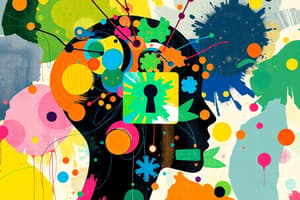Podcast
Questions and Answers
What is the "Black Box Problem" in the context of AI systems?
What is the "Black Box Problem" in the context of AI systems?
The "Black Box Problem" refers to the difficulty in understanding how AI systems, particularly those using deep learning, function internally. While we can see the inputs and outputs, the complex and non-linear processes within the "black box" remain opaque, making it challenging to assess and trust AI's decision-making.
According to Von Eschenbach, what are the two views of trust?
According to Von Eschenbach, what are the two views of trust?
Von Eschenbach's two views of trust are trustworthiness and responsiveness.
What are the five key factors that contribute to trustworthiness in an individual according to Von Eschenbach?
What are the five key factors that contribute to trustworthiness in an individual according to Von Eschenbach?
- Interests (correct)
- Other personal characteristics (correct)
- Character (correct)
- Competency (correct)
- Motivational states (correct)
- Past performance (correct)
Von Eschenbach argues that we should focus on AI systems themselves rather than socio-technical systems.
Von Eschenbach argues that we should focus on AI systems themselves rather than socio-technical systems.
What is a socio-technical system and how does it differ from viewing AI simply as a collection of devices?
What is a socio-technical system and how does it differ from viewing AI simply as a collection of devices?
How does viewing AI as part of a socio-technical system help address concerns about attributing moral properties to AI?
How does viewing AI as part of a socio-technical system help address concerns about attributing moral properties to AI?
What are two main worries raised in the context of AI systems, according to the text?
What are two main worries raised in the context of AI systems, according to the text?
What are the three premises of Cappelen, Goldstein, and Hawthorne's argument for the threat posed by AI?
What are the three premises of Cappelen, Goldstein, and Hawthorne's argument for the threat posed by AI?
Identify two ways in which the first premise of the AI threat argument could be false.
Identify two ways in which the first premise of the AI threat argument could be false.
What are the four ways in which the AI threat argument can be contested?
What are the four ways in which the AI threat argument can be contested?
What are the three challenges associated with the argument for the possibility of superintelligence?
What are the three challenges associated with the argument for the possibility of superintelligence?
What are three issues associated with the Cultural Plateau challenging the argument for an AI existential threat?
What are three issues associated with the Cultural Plateau challenging the argument for an AI existential threat?
What are four challenges associated with the Alignment argument, which suggests that AI systems might not be aligned with human goals?
What are four challenges associated with the Alignment argument, which suggests that AI systems might not be aligned with human goals?
What are the three challenges associated with the Oversight argument, which proposes that AI systems can be safely supervised and controlled?
What are the three challenges associated with the Oversight argument, which proposes that AI systems can be safely supervised and controlled?
Flashcards
Black Box Problem
Black Box Problem
The difficulty in understanding how AI systems, particularly those using deep learning, work internally, despite knowing their inputs and outputs.
Trustworthiness (Von Eschenbach)
Trustworthiness (Von Eschenbach)
A subjective judgment of whether a party is reliable and competent, affecting trust. It can be in a person's character or in their reaction to being trusted.
Socio-technical Systems
Socio-technical Systems
Systems combining technology and social components, like people and their interactions with technology, to achieve goals.
AI Threat (Cappelen, Goldstien, Hawthrone)
AI Threat (Cappelen, Goldstien, Hawthrone)
Signup and view all the flashcards
Technical Plateau
Technical Plateau
Signup and view all the flashcards
Cultural Plateau
Cultural Plateau
Signup and view all the flashcards
Alignment
Alignment
Signup and view all the flashcards
Oversight
Oversight
Signup and view all the flashcards
Recursive Self-Improvement
Recursive Self-Improvement
Signup and view all the flashcards
Existential Threat
Existential Threat
Signup and view all the flashcards
Moral Properties
Moral Properties
Signup and view all the flashcards
Deep Learning
Deep Learning
Signup and view all the flashcards
Fallible Bottlenecks
Fallible Bottlenecks
Signup and view all the flashcards
Instrumental Reasons
Instrumental Reasons
Signup and view all the flashcards
Selection Pressure
Selection Pressure
Signup and view all the flashcards
Intrinsic Goals
Intrinsic Goals
Signup and view all the flashcards
Human-level Intelligence
Human-level Intelligence
Signup and view all the flashcards
Superintelligence
Superintelligence
Signup and view all the flashcards
Phenomenology
Phenomenology
Signup and view all the flashcards
Artifacts
Artifacts
Signup and view all the flashcards
Study Notes
The Black Box Problem
- AI systems' increasing automation and complex information architecture raise concerns about trustworthiness.
- Deep learning models operate in opaque ways, making their inner workings hidden.
- Observers can only see inputs and outputs, not the processes.
- Trust in AI systems is challenging due to their opaque mechanisms.
Von Eschenbach's View of Trust
- Trustworthiness involves judging whether someone is trustworthy.
- Motivational states, interests, character, past performance, competency, and personal characteristics of the trustee influence trust judgments.
- Trustworthiness also pertains to the trustee's responsiveness to the trust.
- Trust requires a reasonable belief in the trustee's competence, as trust in a person is fitting given the circumstances.
- Everyday interactions often rely on competence instead of trust.
- Trust is not sufficient for transactions involving competence alone.
Socio-technical Systems
- Von Eschenbach emphasizes focusing on socio-technical systems, not just AI in isolation.
- Socio-technical systems consider technology as a hybrid of technical and social components.
- This approach avoids attributing moral properties to AI and clarifies trust relationships between humans and technology.
AI Systems and Trust
- AI systems used for diagnosis, prognosis, and disease treatment are part of complex socio-technical systems.
- This complexity involves doctors, patients, technicians, administrators, and other stakeholders.
- Trust in AI systems is related to each agent's understanding, roles, interests, and expertise within a wider framework of the socio-technical system.
- It's wrong to hold AI to standards that don't account for the larger system.
The Threat of Powerful AI
- Cappelen, Goldstein, and Hawthorne present three premises for an AI threat:
- AI systems will become extremely powerful.
- If AI systems become extremely powerful, they will destroy humanity.
- Therefore, AI systems will destroy humanity.
- The argument's four ways to fail include:
- Reaching a technological plateau due to scientific limitations.
- A cultural plateau restricting development due to humanity's collective action.
Concerns About AI
- Technical Plateau: Superintelligence might be impossible or incoherent. Superintelligence is possible if recursive self-improvement is possible. Even without superintelligence, AI can be a threat due to its human-level intelligence.
- Cultural Plateau: Difficulties in agreement, that Al is a threat, individual actors continuing to develop AI, and problems with collective action.
Oversight Concerns
- Long-term perfect oversight requires minimizing failures in oversight tools.
- Even with safeguards, we should expect fluctuations in the relative rates of increases in danger and increases in safety.
Studying That Suits You
Use AI to generate personalized quizzes and flashcards to suit your learning preferences.



